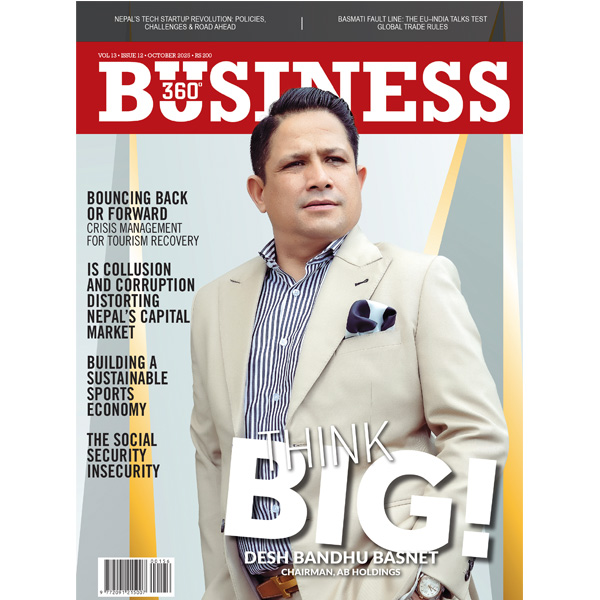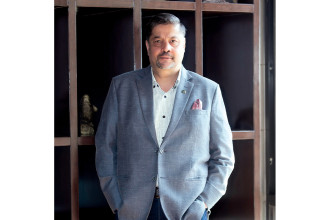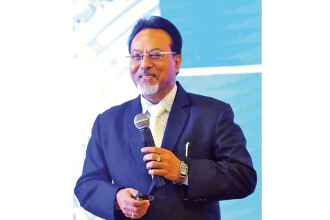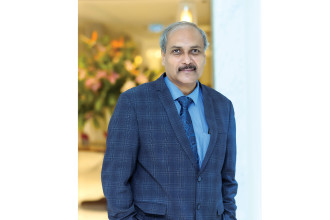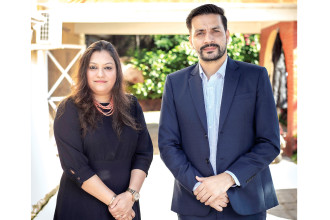
Basanta Adhikary
Director and Spokesperson, Department of Transport Management (DoTM)
Nepal has witnessed immense growth in the number of automobile and private and public vehicles plying its roads. Elevated economic status, busy lifestyle, desire for change and comfort, remittance, access to bank finance are credited for the soaring number of vehicle ownerships. However, the country‘s public transportation system is still considered unmanaged, unsystematic and unpredictable. The trouble one has to endure while commuting in public vehicles is also seen as a reason for more Nepalis opting for their own transport. The government has remained apathetic towards the development of a systematic public transportation sector and the condition of road infrastructure, yet it collects one of the highest amounts of revenue from the automobile sector. Policy level initiatives stand at negligible levels. In this context, Ashok Thapa and Unika Joshi from Business 360 talked with Basanta Adhikary, Director and Spokesperson at the Department of Transport Management (DoTM) on various issues pertaining to transportation management.


How do you review the current transportation system in Nepal?
It feels like the country‘s transportation system is centered in Kathmandu itself. As much as 40,000 public vehicles and 800,000 motorbikes ply the roads of Kathmandu. When you compare the density of Nepal‘s current total number of transport in terms of population and total geographic area, we lag far behind. For example, Sri Lanka is smaller than Nepal yet the country has a total of 6.3 million vehicles while we have only 2.3 million. Here, the use of personal vehicles has really soared high and also the sector carries huge potential. It is because roads are being developed and also because people in and around cities opt for private vehicles. Once the country fully goes into the federal system, more and more people will own vehicles. Till date, we have only 15,000 km of total strategic roads. The development of more roads will not only help promote the transportation but will also curtail the traffic pressure of Kathmandu valley. Road accidents are occurring in terrifying number where the drivers are found mostly guilty. Even in Kathmandu, negligence of the drivers has left the roads and pedestrians high and dry with ever increasing traffic jams which have hindered the systematic traffic management. Most of our roads have not been developed in a scientific manner.
What can be done to manage the traffic system?
I believe if we could develop roads under all bridges, it will largely help to make our traffic movement hassle-free. On the other hand, the government has initiated a project called Kathmandu Sustainable Urban Transport Project (KSUTP) with a plan to enhance the performance of public transport systems, improve traffic operation in congested areas, and enhance walking environment in the central areas of Kathmandu. The project will classify the routes of Kathmandu valley as primary and secondary routes. Big public vehicles will be allowed to ply the roads under the primary route and small vehicles will be permitted to serve in the secondary route. This will help solve the unmanaged traffic of Kathmandu.Why does this mismanagement exist in Nepal‘s public transportation system?
The government so far has not intervened in this sector and all public transportation are owned and controlled by the private sector. There are many owners of public vehicles who have put in money under the provision of Company Act. There is no system of orientation and training for the staff especially drivers and helpers. Such is the condition that the owners do not even know their staff. If you look at taxis, they will stay idle but they won‘t serve you on meter basis. As the public transportation has been scattered among many committees, it is difficult to monitor this sector, and the private sector does not hold itself responsible to the general public. This is also one reason why people prefer personal vehicles. Also, the reliability of public vehicles is very low.What is the DoTM doing to alleviate this?
As per our mandate, we take care of two different aspects. The first is related with the management of the transportation system while the second is related with registration and renewal of vehicles and licences. With the increased import of vehicles into the country, most of our manpower, resources and efforts have been occupied for registration and renewal and other procedural matters. On a daily basis, as much as 2,000 of our staff are focused on works relating to licence. We are left with only a meager amount of time to work towards the management of transportation after giving huge attention to administrative work. This is the reason why we have not been able to focus much on developing the transportation sector in a more efficient, systematic and organised manner.
Despite limited road networks in the nation, vehicle registration has been increasing overwhelmingly. How will this be managed?
Yes vehicle registration has increased sharply of late while the development of road networks is taking place very sluggishly. This of course is a problem in the present time. However, if you compare the number of vehicles compared to our total geographical area, we are still not up to par. With the development of more road networks especially in remote and far areas, the problem will automatically be solved. Another aspect is that Department of Roads is responsible to build roads, DoTM works at the policy level, while Traffic Police is responsible to manage and monitor day to day traffic affairs. These three entities are working independently and lack coordination among each other. If they sit with each other and discuss pertinent issues related to the transportation sector and share each others‘ expertise, it will help solve the current problem.Despite government effort to issue smart licence, it has not happened fully yet. What went wrong?
The smart licence project has been funded by Asian Development Bank (ADB). Initially, it flouted a tender for the same. One of the bidders won the award. But it could only deliver us the cards but could not do much in respect of the software system. Originally, we had planned to take the smart licence out of Kathmandu after three months of its introduction here; however we could not do so because the contractor failed to install necessary technology. We have so far issued around 70,000 smart licences. These licences carry the necessary details, even more than those of the paper ones but the card reading technology has not been established. The whole saga has been an eye-opener for the government that it should not choose a single contractor for an entire project but should award the tender in parts to those having expertise. Now we are working in that direction and will very soon call for a global tender for the remaining work.It is observed that our licence system is not scientific. What are your thoughts?
I agree. We are not at the level of other nations. But change is happening for sure. For example, there was a time when the licence would be delivered at home. You would pay money and receive the licence. But it‘s now in the past. The main problem is that we have maximum work load in Kathmandu office as all 14 Transportation Management Offices have not been fully equipped and resourceful. For instance, we have not been able to create a trial space for four-wheelers in Narayani, Koshi, Dhaulagiri and Karnali and some other zones as we have not been able to purchase land as the government has not outlaid the required money. Government treats us as revenue collectors for national exchequer but has not paid any heed towards our problems. How can we think of improving our systems when we are struggling daily for resources?
Published Date: September 4, 2016, 12:00 am
Post Comment
E-Magazine
RELATED Face 2 Face

